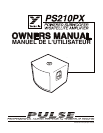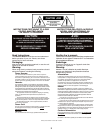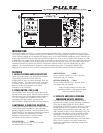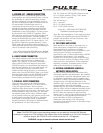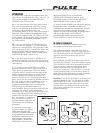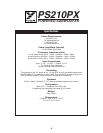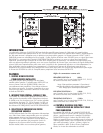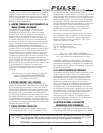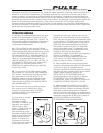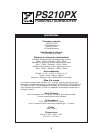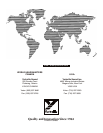
Note: The PS210PX built-in stand mounting adapter can be used with Yorkville SW-Teletube
accessory to support our E160 cabinets. The support tube can be adusted up to it's full 5'4" extension
safely as long as the PS210PX is not inclined more than 10° (10 degrees).
WARNING: Larger or heavier cabinets should not be used!
2
5. GROUND LIFT / GROUND PUSHBUTTON
Whenever mixers, AC-powered signal sources,
and amplifiers are interconnected, there is always
the possibility of a ground-loop being created
because something is not grounded the same as
the rest, or because the other connected units are
all ungrounded. Ground-loops result in a
continuous 60-Hz hum which can be heard
through the speakers. Normally, the PS210PX's
ground reference would be grounded with the
pushbutton in the GND position. If a hum occurs,
try the switch in the GND LIFT position. If this
does not help, restore it to the GND position and
try reversing other grounds - perhaps anything
electrical connected to the mixer. In the GND LIFT
mode, the sleeves of the 1/4" inputs and pin 1 of
the XLR are lifted from ground reference. In the
GND mode, the grounding is done through a 10-
Ohm protection device which prevents damage in
case of accidental cable miswiring.
Note: When driving the PS210PX from a bridged
source, set the GROUND SWITCH to GND LIFT!
6. LINE/SPEAKER PUSHBUTTON
This feature enables you to drive the PS210PX's
inputs with either line-level or speaker-level
signals. For example, if you have connected a
mixer's MAIN (line-level) output to one of the
PS210PX's inputs, you would push the button up
into the LINE position. If, on the other hand, you
have connected a parallel connection from
another speaker being driven by a mixer/amp or
power amp, into the PS210PX's input, you would
push the button down into the SPEAKER position.
It is important for this to be set correctly as to
ensure proper performance of the product.
7. PARALLEL INPUT CONNECTORS
There are three inputs to the PS210PX power
amplifiers, consisting of two 1/4" jacks and one
3-pin XLR-type connector. The two power
amplifiers share these inputs. In other words, the
signal coming into any one of the connectors goes
to both amplifiers at the same time (i.e. there are
no separate inputs to the amps). All three inputs
are in parallel so that any one of them can be used
to feed signal to another PS210PX or, if speaker-
level signal is driving the inputs, to additional
speaker enclosures. All inputs are balanced when
the pushbutton is in the LINE position.
The 1/4" inputs are TRS (Tip-Ring-Sleeve) wired.
Tip = 0° phase (positive) / Ring = 180° phase
(reverse) / Sleeve = ground.
The XLR wiring is...
Pin 1 = ground.
Pin 2 = 0° phase (positive)
Pin 3 = 180° phase (reverse)
Note: see 5. GROUND LIFT/GROUND
Pushbutton regarding grounding.
Since the input impedance is very high (more than
17k-Ohms) any amplifier driving the PS210PX in
parallel with speakers will not encounter a low
load impedance situation.
8. THE POWER AMPLIFIERS
Both amplifiers are rated at 300 watts into 4-
ohms and feature comprehensive protection
from both thermal and input overloads.
Additionally, the amplifiers are regulated by full-
time electronic limiting and automatic
equalization (see 9. Internal Subwoofer LIMITER
& Automatic Equalization). The amplifier
heatsink fins on the back panel should be kept
well away from walls or anything which could
restrict air flow around them. If the subwoofer
amplifier overheats, its output power will be
reduced by the limiter to compensate.
9. INTERNAL SUBWOOFER LIMITER &
AUTOMATIC EQUALIZATION
In order to achieve maximum utilization of the
subwoofer amplifier and subwoofers, the amplifier
is regulated by a sonically transparent limiter and
an automatic equalization circuit. Together, they
respond to a variety of potential hazards including
excessive heat, and clipping distortion in the
amplifier; also, excessive speaker cone excursions
or even speaker voicecoil overheating.
Additionally, the EQ ensures extended deep bass
down to 45Hz at low to moderate operating levels
To protect the woofers at higher operating levels,
the EQ's bass pre-emphasis is reduced as the
limiter cuts in. At very high limiting levels, the EQ
will actually cut the response below 60Hz to
ensure that there will be no distortion or
subwoofer cone damage. This still permits
maximum clean sound pressure in the 90Hz range
(for bass drum kicks).



